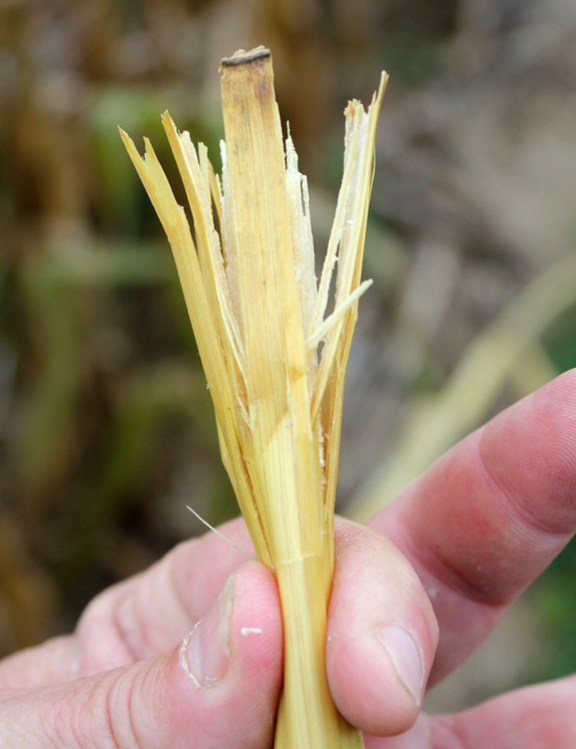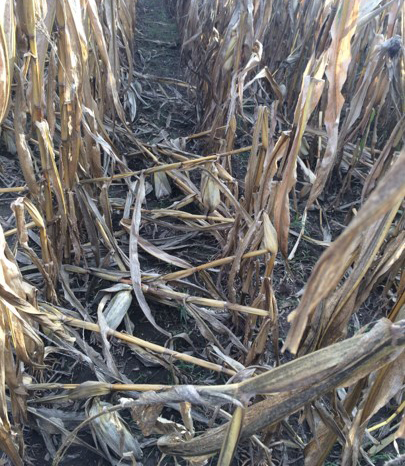Check your southern Michigan corn fields for tar spot, lodged corn and stalk strength now
While many later planted corn fields may not suffer extreme yield losses, you should be monitoring all tar spot-infected fields for stalk strength.

Tar spot has been much more widespread across portions of southern Michigan than many producers may realize. Part of the reason for this is that some of the infection occurred much later in the season than we would normally expect leaf diseases to be active. Because of delayed planting, corn plants were much more immature than usual. The abundance of green leaf tissue allowed tar spot to spread during early to mid-September. While many of these later planted fields may not suffer extreme yield losses, you should be monitoring all tar spot-infected fields for stalk strength.
Tar spot stroma look like splatters of used engine oil on the leaves and husks. Luckily, the lesions are quite easy to identify on leaf tissue that has turned brown.
Fields that are the most at risk from lodging are irrigated fields where tar spot lesions were first being found in late July or early August. It is thought that irrigation provides for extended periods of leaf wetness, which helps the disease to gain an early foothold in these fields.
While the irrigated fields are likely the most at risk for lodging, later planted fields with high numbers of tar spot lesions on the leaves may end up having lower stalk strength as well.
There are wide differences between hybrids in their ability to tolerate tar spot. Some of the more susceptible hybrids may have significant loss of leaf tissue death with only moderate numbers of lesions. In other cases, the leaves may be covered in tar spot stroma, but the affected stalks may not exhibit significant stalk weakness. Conducting a push or pinch test can help you to determine if the plants are losing stalk integrity.

Fields we have seen with lodging from tar spot often can be identified by pinching the stalk with your thumb and fore finger between 10-18 inches above the ground. If the stalk strength is compromised, you will be able to pinch the stem with relative ease.
Alternatively, you can grab the stalks around the ear level and push them away from you to about a 30-degree angle (an arm length). The push test can determine the likelihood that the corn will be able to withstand normal weather conditions for the next week to 10 days under normal wind conditions.
Plants with stroma that easily lodge at the lower stem level, especially if there is not significant stem discoloration, are likely caused by tar spot. Other forms of stalk rots usually are associated with colors that can range from black to white.
Thunderstorms or the passage of strong cold fronts can cause high winds that can quickly cause excessive lodging. Keep an eye out for these kind of weather conditions in the forecast. Be prepared to conduct stalk strength tests and change your harvest plans to remove fields that have poor stalk strength when necessary.

For areas that have not had issues with tar spot in the past, check your fields for signs of the fungus on the leaves. It may not be very hard to find. Many of the fields that have low levels of tar spot tend to have higher initial incidence of the disease on plants along a field edge. Martin Chilvers, a field crops pathologist at Michigan State University Extension, thinks this may have something to do with increased air flow allowing the plants along field edges to have more exposure to spores.
It is important to understand that many fields that have severe tar spot issues in southwest Michigan began with low levels of lesions a year ago. By identifying tar spot in your corn fields, you can help determine if your 2020 corn is at an increased risk for the fungal disease.
Heavy rainfall has also caused some minor grain molds in corn ears, particularly if feeding damage from western bean cutworm or corn earworm occurred in the field. Extended periods of contact with the ground will likely cause additional damage to the lodged corn.



 Print
Print Email
Email